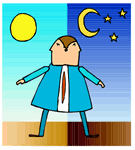The teacher librarian must model and support legal and ethic practices related to copyright and other issues of intellectual property.
 I found a great cartoon on the Internet. Can I legally put it in my library newsletter that goes out to parents?
I found a great cartoon on the Internet. Can I legally put it in my library newsletter that goes out to parents?
A teacher wants to show a television program she recorded last year. Is this legal?
The principal wants to copy and distribute a chapter out of a book about reading across the curriculum. Is that legal?
The three people above are facing copyright issues. It's likely that none of these activities are legal. However, permissions can easily be acquired in each case.
What is Copyright?
Copyright is granted to the creators of works to protect their interest in the work and to encourage people to take risks and disseminate information. The copyright law is intended to protect against unauthorized printing, publishing, importing, or selling of multiple copies of a work. A fair use law was developed to provide guidelines in the use of copyrighted materials.
What is Fair Use?
Fair use is intended to balance the interest of the copyright owners with the needs of the users. There are four requirements that must be passed to meet the law.
- the purpose and character of use
- the nature of the work
- the amount, substaniality or portion
- the potential market
Check Your Understanding
![]() Information Power - Information Access and Delivery: Principle 7. The information policies, procedures, and practices of the library media program reflect legal guidelines and professional ethics. (p. 83, 97)
Information Power - Information Access and Delivery: Principle 7. The information policies, procedures, and practices of the library media program reflect legal guidelines and professional ethics. (p. 83, 97)
Make It Real
Read More About It
Copyright Clearance Center
http://www.copyright.com/
The largest licenser of text reproduction rights in the world, was formed in 1978 to facilitate compliance with U.S. copyright law. CCC provides licensing systems for the reproduction and distribution of copyrighted materials in print and electronic formats throughout the world.